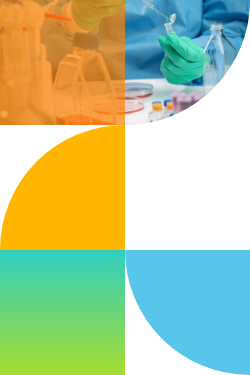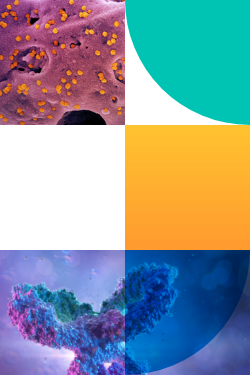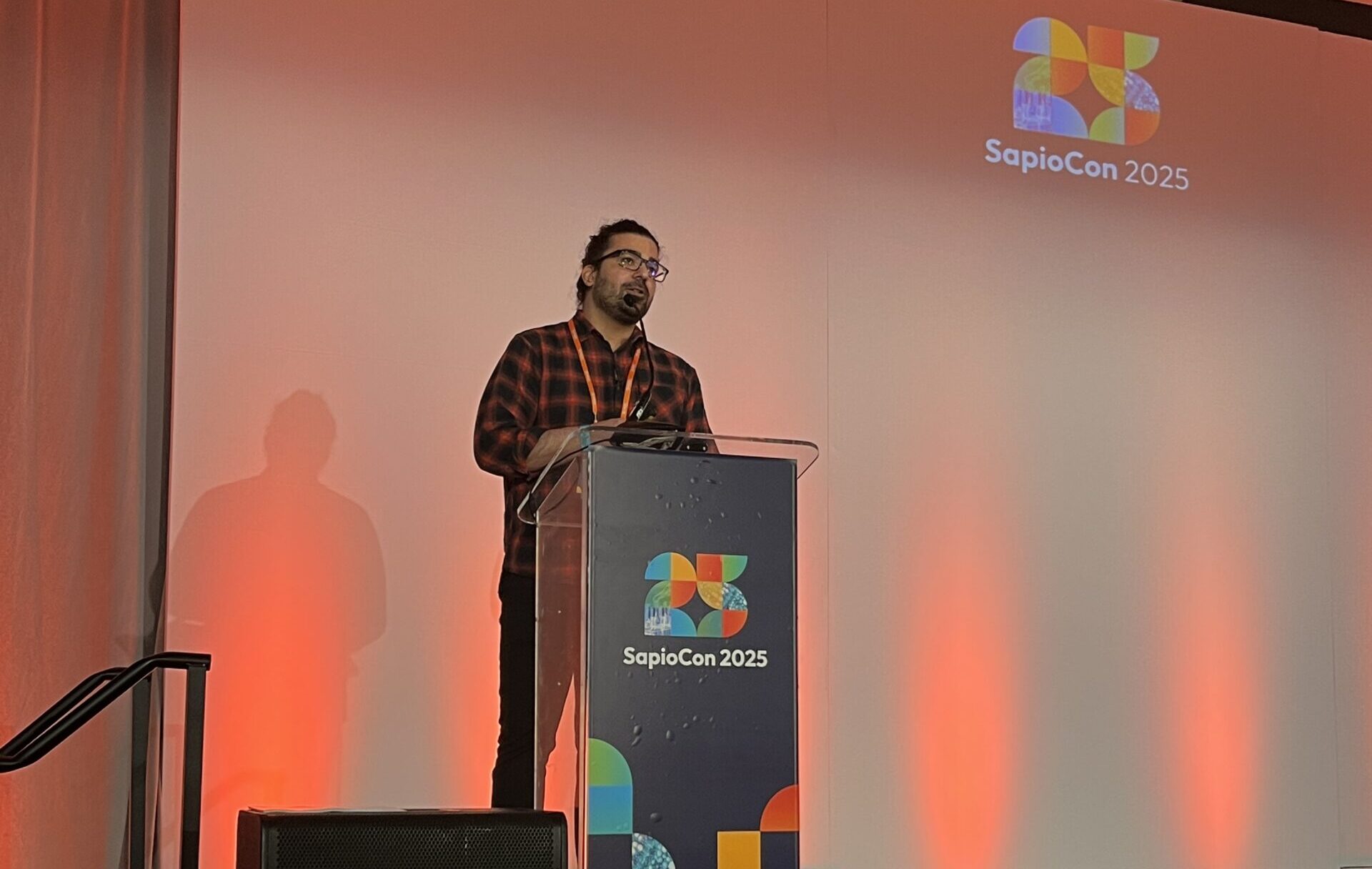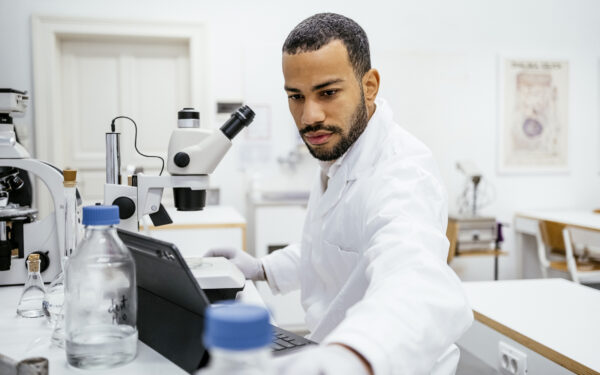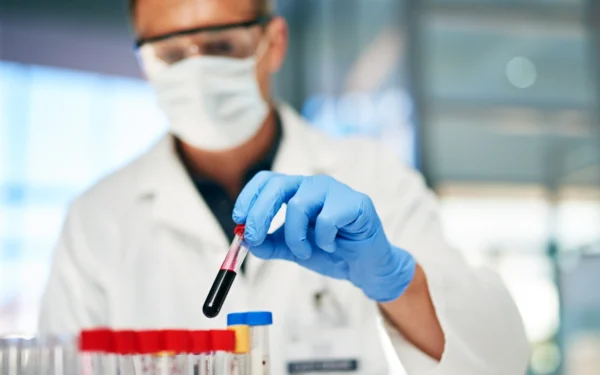This keynote presentation at SapioCon 2025 was the most relatable to me—Shane Kamil, Solution Lead for Digital Transformation at Olink Proteomics (part of Thermo Fisher), shared Olink’s journey toward a modern, fully integrated Unified Laboratory Information System (ULIS) with Sapio Sciences’ LIMS software at its core.
Kamil’s presentation was a masterclass in how growing scientific organizations must evolve beyond outdated tools, especially as they scale. Olink, a global leader in proteomics solutions, had reached a tipping point: its Excel-based tracking systems, fragmented workflows, and a five-year-old LIMS that no longer met the needs of a 1,000-person company were becoming major roadblocks. Their transformation wasn’t just about adopting a new system—it was about ensuring scientists could focus on science, not on fixing broken processes.
Growing pains—Why Olink needed change
Kamil didn’t mince words when discussing the challenges Olink faced. The company’s early days relied on scientist-managed Excel spreadsheets and manual processes, but rapid growth introduced data silos, duplicate efforts, and inconsistencies between teams.
A major issue? No single source of truth. Researchers, product development teams, and manufacturing staff all worked with separate, disconnected systems, making it difficult to track progress, ensure data integrity, or scale operations effectively.
Additionally, Olink’s legacy LIMS software, implemented five years ago “based on the loudest voices in the lab,” as Kamil joked, no longer met the needs of a company approaching 1,000 employees. The system lacked flexibility, and user dissatisfaction was high. As Kamil pointed out, it’s not just about having a LIMS, it’s about having the right LIMS software.
A user-centered revolution
What set Olink’s approach apart was its unwavering commitment to user engagement. Kamil’s description of spending most of 2023, with his team, visiting all Olink sites to understand actual processes was impressive. It reminded me of the importance of ground-level insights in driving meaningful change.
I was particularly amused by their discovery of discrepancies between documented processes and actual practices—a common occurrence because in the fast-paced world of life sciences, official protocols often lag behind the reality of day-to-day operations.
Additionally, many employees were skeptical about change due to bad experiences with previous digital rollouts. To overcome this, the team encouraged users to think about their ideal system without the constraints of existing limitations.
Balancing the needs of R&D (which thrives on flexibility) and contract research organization (CRO)/customer service operations (which require strict regulations) became a focal point. The ultimate goal was to find a system that works for all users—scientists, product developers, and manufacturing teams.
From waterfall to agile—A new mindset for implementation
Beyond upgrading its LIMS, Olink transformed its entire approach to IT project management. Historically, the company relied on a rigid waterfall approach, where requirements were gathered upfront and implemented in one massive rollout.
Olink shifted to an agile methodology, which aligned perfectly with Sapio’s iterative approach to implementation. Instead of waiting months to see progress, the teams participated in two-week sprint demonstrations that saw their feedback translated into functionality—a model many organizations could benefit from adopting.
This bottom-up approach allowed users to drive changes, making them feel invested in the process rather than forcing a system upon them. As Kamil emphasized, “Users engaging users for real change” was the key to digital transformation.
The birth of ULIS
The result of these efforts is ULIS (Unified Laboratory Information System), which caught my attention. In an era where data silos can significantly hinder progress, Olink’s vision of connecting R&D, product development, manufacturing, and analysis teams is truly forward thinking.
Kamil’s emphasis on creating a single source of truth for all lab-related, manufacturing, and biologics processes resonates with other presentations I attended at SapioCon 2025. It is clear that the ability to seamlessly integrate data across departments while protecting sensitive information is not just a luxury—it’s a necessity for staying competitive.
Looking ahead—Challenges and opportunities
As Kamil outlined Olink’s road ahead, including the ambitious goal of a first release of ULIS by April 2025, I couldn’t help but feel excited about the future of proteomics research. The focus on eliminating legacy systems (Excel sheets, outdated LIMS, and self-coded applications) is a bold move that promises to streamline operations significantly.
However, the mention of data migration as a significant challenge was a sobering reminder of the complexities involved in such transformations. It is a hurdle that many in the audience seemed to nod in recognition of, highlighting a common pain point in the industry.
Olink’s legacy systems contained years of historical data—some structured, some not—and ensuring a smooth transition required a well-planned data migration pathway.
To make the transition as seamless as possible, Olink has been using sandbox environments to test the new system with real data before full deployment. This approach allows scientists to interact with the new platform, provide feedback, and ensure the system meets their needs before fully committing to it.
Key takeaways: Olink’s digital transformation as a model for others
Kamil’s presentation provided a blueprint for how scientific organizations can successfully transition from outdated, fragmented systems to a unified digital workflow. The key lessons from Olink’s experience include:
- User involvement is non-negotiable. Digital transformation should be driven by the scientists who will actually use the system, not just by IT.
- An agile approach accelerated adoption. Short feedback loops ensure that user needs are met in real time, preventing resistance to change.
- Legacy system elimination must be strategic. Simply introducing a new system isn’t enough—organizations must actively phase out old, inefficient tools.
Concluding thoughts
Olink’s journey with Sapio LIMS software is a testament to why digital transformation in life sciences is no longer optional—it’s essential. The days of managing critical scientific data in Excel sheets and disconnected legacy systems are numbered. Companies that embrace agile, user-druve abd scalable informatics solutions will lead the next wave of innovation.
With ULIS, Olink is not just modernizing its laboratory operations. It is setting a precedent for how scientific enterprises should evolve in the digital age. I can’t wait to see how such innovations will shape our industry in the years to come.
